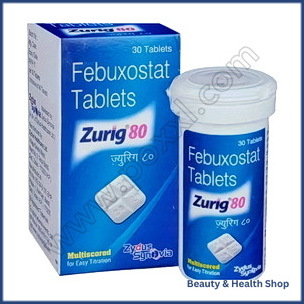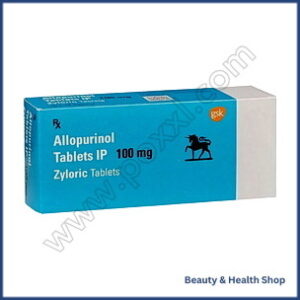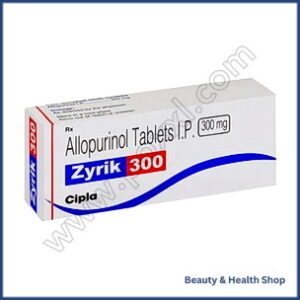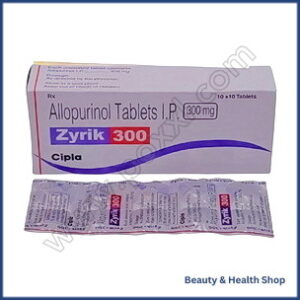ADDICTION
ALCOHOL DEPENDENCE
QUIT SMOKING
ALLERGY
ANTI FUNGAL
FUNGAL INFECTION
FUNGAL NAIL INFECTIONS
ANTI-REJECTION DRUGS
ANTI WORM
ANTIBIOTIC
BACTERIAL INFECTIONS
ARTHRITIS
GOUT
OSTEOARTHRITIS
RHEUMATOID ARTHRITIS
BLOOD
LOW PLATELET COUNT
THROMBOPHLEBITIS
VARICOSE VEINS
COLON
ANAL FISSURE
PILES
ULCERATIVE COLITIS
DIABETES CARE
DIABETES INSIPIDUS
DIABETES TYPE
DIABETIC FOOT ULCERS
GLUCOSE MONITOR
EYES/EAR CARE
DRY EYES
EYE CARE
EYE EXAMINATION
EYE INFECTION
EYE LASHES
EYE PAIN
GLAUCOMA
OCULAR HYPERTENSION
UVEITIS
FEVER CARE
MALARIA
RHEUMATIC FEVER
TYPHOID FEVER
GASTROINTESTINAL
ACIDITY
CONSTIPATION
CROHN'S DISEASE
DIARRHOEA
GALLBLADDER STONES
INTESTINAL ULCERS
IRRITABLE BOWEL SYNDROME
MOTION SICKNESS
NAUSEA
Zurig 80 mg (Febuxostat)
| Active Ingredient (Generic Name): | Febuxostat |
|---|---|
| Indication: | Gout |
| Manufacturer: | Zydus Cadila Pharma |
| Packaging: | 30 tablets in one bottle |
| Strength: | 80 mg |
From: $41.00
You are prescribed Zurig 80 mg (Febuxostat) for treating gout symptoms and reducing uric acid levels in your blood. This medication functions by inhibiting xanthine oxidase, an enzyme responsible for uric acid production, thus decreasing its buildup in your joints and relieving symptoms like joint pain. Initially, you may notice relief from pain, decreased frequency of gout attacks, and enhanced joint health. To maximize the benefits of your treatment, it is crucial to adhere to the correct dosage, be aware of potential interactions, and take necessary precautions. Gain insights on optimizing your treatment outcomes and effectively managing your condition.
Main Points
- Zurig 80 mg (Febuxostat) lowers uric acid levels to relieve gout symptoms, joint pain, and prevent kidney stones.
- The standard dose is one 80 mg tablet daily, with or without food, and regular check-ups for monitoring and adjustments.
- Caution is necessary when combining Febuxostat with other medications to avoid adverse reactions.
- Special care is needed for individuals with cardiovascular issues, pregnant or nursing women, the elderly, and those with kidney or liver problems.
- Seek immediate medical help if overdose symptoms like nausea, vomiting, or abdominal pain occur.
What Is Zurig 80 mg?
You have been prescribed Zurig 80 mg, a type of febuxostat medication used to treat hyperuricemia, a condition characterized by high levels of uric acid in the blood. This medication is typically recommended for patients who have not responded well to other treatments or cannot use other urate-lowering therapies. It’s essential to understand that Zurig 80 mg is not a cure for gout but rather a way to manage its symptoms.
Febuxostat, the active component in Zurig 80 mg, belongs to a class of drugs known as xanthine oxidase inhibitors. These inhibitors work by reducing the production of uric acid in the body, leading to lower levels in the blood. By following the prescribed dosage of Zurig 80 mg, you can expect a notable decrease in uric acid levels, which can help relieve symptoms like joint pain and inflammation. Adhering to your doctor’s instructions is crucial for achieving optimal results.
How Does Febuxostat Work?
Zurig 80 mg contains the active ingredient Febuxostat, which works by selectively inhibiting xanthine oxidase, an enzyme crucial for uric acid production in the body. By targeting this enzyme, Febuxostat reduces the conversion of purines into uric acid, leading to lower levels of uric acid in the blood and preventing its accumulation in the joints. This mechanism helps alleviate gout symptoms like joint pain and inflammation and can also lower the risk of complications such as kidney stones and damage. Understanding how Febuxostat operates can aid in managing gout symptoms and enhancing overall quality of life.
Benefits of Zurig 80 mg
When taking Zurig 80 mg, you can expect effective treatment for gout by reducing uric acid levels in your body. This leads to rapid pain relief, helping you manage symptoms and enhance your quality of life. Lowering uric acid levels also reduces the frequency of gout attacks, making it easier to live with this condition.
Effective Gout Treatment
Zurig 80 mg effectively reduces uric acid production by inhibiting xanthine oxidase, offering a reliable treatment for gout symptoms. This medication lowers uric acid levels, decreasing the frequency and severity of gout attacks. Managing gout with Zurig 80 mg helps control symptoms by reducing inflammation and swelling in joints, improving mobility for daily activities. Consistent use of Zurig 80 mg supports long-term gout symptom management, enhancing overall quality of life. Incorporating Zurig 80 mg into a treatment plan can lead to significant relief from gout discomfort and a return to an active lifestyle.
Reduces Uric Acid
Taking Zurig 80 mg regularly helps reduce uric acid levels, lowering the risk of gout attacks. By inhibiting xanthine oxidase, an enzyme that produces uric acid, Zurig 80 mg decreases the amount of uric acid in the bloodstream. This reduction in uric acid levels prevents the formation of uric acid crystals in the joints, which can lead to painful gout attacks.
High uric acid levels are linked to a higher risk of gout attacks, while lower levels are associated with a reduced risk. By using Zurig 80 mg to lower uric acid levels, individuals can lessen the likelihood of experiencing gout attacks. This improvement can enhance overall quality of life by enabling individuals to carry out daily activities without the discomfort of gout episodes.
Fast Pain Relief
Zurig 80 mg offers rapid relief from gout pain by lowering uric acid levels in the body. The active ingredient, Febuxostat, acts quickly to alleviate symptoms like inflammation, swelling, and tenderness. Pain and discomfort typically diminish within 24-48 hours of taking Zurig 80 mg, allowing for a quicker return to normal activities.
This swift pain relief is crucial for individuals prone to frequent gout attacks, as it helps prevent future episodes and reduces the risk of joint damage. By promptly addressing uric acid levels, complications such as kidney stones and tophi formation can also be minimized. Zurig 80 mg enables individuals to manage gout symptoms effectively and regain control of their daily lives.
Uses and Indications
Zurig 80 mg is commonly prescribed to treat gouty arthritis and reduce uric acid levels in the body. It is also used to manage hyperuricemia, a condition characterized by elevated uric acid levels in the blood. Understanding these primary indications can help in improving patient outcomes by effectively alleviating symptoms associated with these conditions.
Gouty Arthritis Treatment
Febuxostat, found in Zurig 80 mg, is indicated for managing hyperuricemia in gout patients to reduce flare-ups and relieve symptoms. Zurig 80 mg can help individuals with gout regain control over their lives by lowering uric acid levels, resulting in fewer flares and less joint pain. This medication promotes improved joint health and reduces the risk of long-term damage. Following the prescribed regimen of Zurig 80 mg can lead to a better quality of life, free from the challenges of gout.
Uric Acid Reduction
Lowering uric acid levels is crucial in preventing crystalline deposits in joints, a key factor in gout attacks. Zurig 80 mg (Febuxostat), a xanthine oxidase inhibitor, effectively reduces uric acid production, leading to decreased levels in the blood and urine. By maintaining lower uric acid levels with Zurig 80 mg, gout flares can be minimized, symptoms alleviated, and joint health improved. Consistent use of this medication can significantly reduce gout attacks, providing better control over daily activities.
Hyperuricemia Management
Manage hyperuricemia effectively with Zurig 80 mg, indicated for chronic hyperuricemia in gout patients. Zurig 80 mg reduces uric acid production, lowering gout attack risk and related complications. Following prescribed dosage, expect a notable decrease in serum uric acid levels, relieving joint pain, swelling, and inflammation. Zurig 80 mg also prevents recurrent gout attacks by maintaining optimal uric acid levels, reducing flare frequency and severity. Clinical studies show improved quality of life in gout patients, aiding daily activities. In a comprehensive treatment plan, Zurig 80 mg helps manage hyperuricemia and gout for a more active, pain-free lifestyle.
Dosage and Administration
The recommended dose of Zurig 80 mg (Febuxostat) is one 80 mg tablet taken orally once daily. Take the tablet at the same time each day, preferably in the morning. Swallow it whole with a full glass of water, without crushing, chewing, or splitting it. Zurig 80 mg can be taken with or without food since food does not impact its absorption.
Your doctor may monitor your serum uric acid levels when you start taking Zurig 80 mg to ensure it is effective. The dosage may be adjusted based on your response. Follow the dosage instructions carefully and attend follow-up appointments as scheduled.
Side Effects and Warnings
Common side effects of Zurig 80 mg (Febuxostat) include liver enzyme abnormalities, nausea, joint pain, increased liver enzymes, diarrhea, headache, dizziness, and rash. It is important to monitor these side effects as they may impact daily activities. If you experience severe or persistent side effects, contact your doctor promptly for possible dosage adjustments or alternative treatments. Seek immediate medical attention if you have signs of an allergic reaction, such as difficulty breathing or swelling. Being aware of these potential side effects will help you manage them effectively and ensure a safe treatment experience with Zurig 80 mg (Febuxostat).
Drug Interactions and Contraindications
Febuxostat, found in Zurig 80 mg, can interact with specific medications such as azathioprine, mercaptopurine, and theophylline, potentially increasing the risk of adverse reactions. Understanding these interactions is crucial, as they can affect the effectiveness and safety of your treatment. Combining Febuxostat with azathioprine may heighten the possibility of bone marrow suppression, resulting in issues like anemia, low white blood cell count, and reduced platelet count.
Moreover, the interaction between Febuxostat and mercaptopurine can elevate the chances of gastrointestinal toxicity. Caution is advised when taking Febuxostat alongside theophylline, as it can raise theophylline levels to a toxic extent. It is essential to disclose all medications you are currently using, including prescriptions, over-the-counter drugs, vitamins, and supplements to your healthcare provider. They may need to adjust your dosage or closely monitor you for potential interactions. Being mindful of these interactions can help minimize the risk of adverse reactions and ensure the safe and effective use of Zurig 80 mg.
Precautions and Special Populations
Caution is advised for individuals with a history of cardiovascular disease when taking Zurig 80 mg, as Febuxostat may heighten the risk of cardiovascular events, especially in those with pre-existing conditions. Prior to commencing treatment, it is crucial to discuss your medical history with your healthcare provider.
Special considerations include:
- Pregnant or breastfeeding women: The safety of Febuxostat during pregnancy and lactation has not been determined. Consult a healthcare professional before using Zurig 80 mg.
- Elderly patients: Efficacy and safety of Febuxostat in the elderly have not been specifically researched. Adverse reactions should be monitored, and dosage adjustments may be necessary.
- Patients with severe renal impairment: Febuxostat is not recommended for individuals with severe renal impairment. Dosage modification might be required for those with mild to moderate renal impairment.
- Patients with liver disease: The safety of Febuxostat in patients with liver disease has not been established. Regular monitoring of liver function and dosage adjustments may be needed.
- Patients experiencing gout flare-ups: Febuxostat could potentially worsen gout flares. Monitoring for gout flare signs and adjusting treatment accordingly is advisable.
Strictly adhere to your healthcare provider’s guidance and monitoring instructions to ensure the safe and effective use of Zurig 80 mg.
Overdose Symptoms and Treatment
If an overdose is suspected, it is crucial to promptly recognize the signs and seek immediate assistance. Symptoms such as nausea, vomiting, and abdominal pain may suggest an overdose of Zurig 80 mg (Febuxostat). In case of an overdose, seek emergency medical help without delay and provide detailed information about the overdose to healthcare professionals.
Recognizing Overdose Signs
To recognize an overdose of Zurig 80 mg (Febuxostat), watch for symptoms like nausea, vomiting, dizziness, abdominal pain, rapid heart rate, and confusion. These signs indicate a potential overdose and require prompt medical attention to prevent serious consequences.
Emergency Treatment Steps
In case of suspected Zurig 80 mg overdose, seek immediate medical help by calling emergency services or taking the patient to the hospital as soon as possible. Timely medical intervention is crucial to prevent serious complications. Provide details such as the overdose time, amount taken, and any symptoms to the medical team.
At the hospital, healthcare professionals will begin emergency treatment to stabilize the patient’s vital signs and address symptoms. This may involve administering activated charcoal to absorb the medication, followed by supportive care for symptoms like nausea, vomiting, and abdominal pain. In severe instances, procedures like gastric lavage or induced vomiting may be necessary to remove the medication from the stomach.
It is essential to understand that managing symptoms and preventing further issues are the main goals of Zurig 80 mg overdose treatment. Avoid trying to manage the overdose at home, as it can delay medical care and worsen the patient’s condition. Seek immediate medical assistance for the best possible outcome.
Storage and Disposal
When storing Zurig 80 mg (Febuxostat) tablets, keep them in their original packaging in a cool, dry place away from direct sunlight and moisture. Store them in a closet or drawer, avoiding high-temperature areas like near heating vents. Do not keep them in bathrooms due to humidity. Keep the tablets out of reach of children and pets to prevent accidental ingestion. Dispose of expired or unused tablets following guidance from your pharmacist or local authorities. Always check the expiration date and tablet condition before use. If unsure about storage or disposal, seek advice from your healthcare provider or pharmacist.
Alternatives to Zurig 80 mg
When considering alternative treatments for gout and hyperuricemia, patients may explore other medications that reduce uric acid production. Allopurinol, a xanthine oxidase inhibitor, functions similarly to febuxostat by reducing uric acid production and easing gout symptoms. Pegloticase is another option, administered intravenously to convert uric acid into allantoin for easier kidney excretion. Benzbromarone, a uricosuric agent, increases uric acid excretion in urine, while lesinurad, a selective uric acid reabsorption inhibitor, can be used in combination with a xanthine oxidase inhibitor to further lower uric acid levels. Consulting a doctor is crucial to determine the best alternative treatment based on individual needs, weighing the benefits and risks of each medication to create a personalized treatment plan. Exploring these alternatives can lead to finding an effective solution for managing gout and hyperuricemia symptoms.
Frequently Asked Questions
Can I Take Zurig 80 mg With Antacids or Acid Reducers?
When considering taking antacids or acid reducers with Zurig 80 mg, caution is advised. Avoid taking antacids or acid reducers within two hours of Zurig 80 mg to prevent reduced absorption. If necessary, space out the doses by at least two hours to minimize potential interactions. Always seek personalized advice from your healthcare provider or pharmacist.
Can Zurig 80 mg Be Crushed or Broken Before Taking?
When taking medications, it is generally not recommended to crush or break tablets or capsules unless advised by a healthcare professional. Altering the form of the medication can affect its absorption rate, potentially leading to inconsistent effects or adverse reactions. It is important to consult with a doctor or pharmacist before making any changes to how you take your medication.
Is Zurig 80 mg Safe for Pregnant or Breastfeeding Women?
When considering medication during pregnancy or breastfeeding, it’s important to prioritize safety. Certain medications may pose risks to the baby, so it’s generally advised to be cautious. It is recommended to consult a healthcare provider before taking Zurig 80 mg or any medication during pregnancy or while breastfeeding. A doctor can provide guidance on the potential benefits and risks, allowing you to make an informed decision about your health and the well-being of your baby.
Can Zurig 80 mg Be Used to Treat Gouty Arthritis Flare-Ups?
When managing gouty arthritis flare-ups, it’s important to note that Zurig 80 mg, containing Febuxostat, is not commonly used to treat acute gout attacks. It is typically prescribed for long-term urate-lowering therapy to prevent future flares. For acute attacks, other medications like colchicine, corticosteroids, or NSAIDs are usually recommended to reduce inflammation and relieve symptoms. Your healthcare provider will determine the most suitable treatment plan for your individual needs.
Will Zurig 80 mg Affect My Blood Test Results?
When taking medication, it’s important to consider its potential impact on blood test results. Certain medications, like Zurig 80 mg, can affect lab outcomes, potentially leading to inaccurate diagnoses or treatment plans. Specifically, Zurig 80 mg may lower uric acid levels, which could influence the diagnosis or monitoring of gout.
Conclusion
You have been prescribed Zurig 80 mg for gout or hyperuricemia management. By inhibiting xanthine oxidase, this medication reduces uric acid production, relieving symptoms and preventing complications. Follow the prescribed dosage carefully, and be mindful of potential interactions and side effects. If you encounter any problems or have questions, consult your healthcare provider. Proper use of Zurig 80 mg can help you control your condition and enhance your quality of life.








There are no reviews yet.